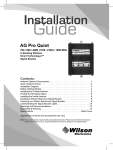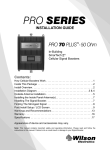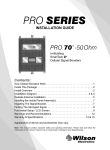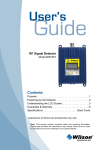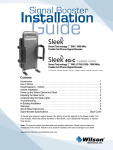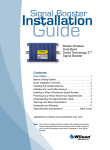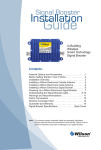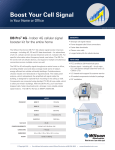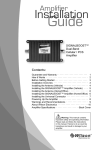Download Wilson Electronics 304453 3G UMTS wireless network equipment
Transcript
E OT OT YP AG Pro Quint TM Selectable 700 / 800 / 1700-2100 / 1900 MHz (Band 2, 4, 5, 12/17 & 13) In-Building Wireless Smart Technology ™ Signal Booster Contents: PR Antenna Options & Accessories . . . . . . . . . . . . . . . . . . . . . . . . . . . . . . . 1 Quick Install Overview. . . . . . . . . . . . . . . . . . . . . . . . . . . . . . . . . . . . . . . 2 Installation Diagram. . . . . . . . . . . . . . . . . . . . . . . . . . . . . . . . . . . . . . . . . 3 Before Getting Started. . . . . . . . . . . . . . . . . . . . . . . . . . . . . . . . . . . . . . . 4 Finding the Strongest Signal. . . . . . . . . . . . . . . . . . . . . . . . . . . . . . . . . . 6 Outside Antenna Installation. . . . . . . . . . . . . . . . . . . . . . . . . . . . . . . . . . 7 Installing the Inside Antenna. . . . . . . . . . . . . . . . . . . . . . . . . . . . . . . . . . 8 Installing a Wilson Electronics Signal Booster. . . . . . . . . . . . . . . . . . . . . 9 Powering up a Wilson Electronics Signal Booster. . . . . . . . . . . . . . . . . 10 Warnings and Recommendations. . . . . . . . . . . . . . . . . . . . . . . . . . . . . 16 Guarantee & Warranty. . . . . . . . . . . . . . . . . . . . . . . . . . . . . . . . . . . . . . 18 Specifications . . . . . . . . . . . . . . . . . . . . . . . . . . . . . . . . . . . . . Back Cover Appearance of device and accessories may vary. Note: This manual contains important safety and operating information. Please read and follow the instructions in this manual. Failure to do so could be hazardous and result in damage to your Signal Booster. Installation Instructions for the Following Wilson Electronic Signal Booster: AG Pro™ Quint Selectable (Band 2, 4, 5, 12 & 13) 700 / 800 / 1700-2100 / 1900 MHz In-Building Wireless Smart Technology ™ Signal Booster Model #273470 FCC: PWO273470 How it Works Wilson Electronics Signal Boosters are bi-directional devices that deliver service levels consistent with what would be expected in areas of high cell network coverage. They amplify a weak or shadowed signal in mobile, M2M, marine and in-building applications. When using a Wilson Electronics Signal Booster in conjunction with Wilson Electronics antennas, the Outside Antenna will collect the cell tower signal and send it through the cable to the Signal Booster. The signal is then amplified and retransmitted through the Inside Antenna into the room. Cell phones and cellular data cards in that area then communicate with the improved signal. When a cell phone or cellular device transmits, the signal is received by the Inside Antenna, amplified by the Signal Booster and transmitted back to the cell tower through the Outside Antenna. Inside this Package Note: Kits may contain different accessories AC/DC Power Supply 5V / 4A Signal Booster (859998) Outdoor Antenna Options & Accessories 1. Wide Band Directional Antenna 700 - 2700 MHz (304411) Note: The outside fixed antenna must be connected with a minimum of 26’ of RG58 coaxial cable (950630}. 2. Pole Mount Wide Band Panel Antenna (304453) 1 Indoor Antenna Options & Accessories A. Wide-Band Panel Antenna 700-2700 MHz (multiple mounting options available) B. 50 Ohm Lightning Surge Protector N Connector (859902) Splitter options on page 9 2 A 1 B Appearance of device and accessories may vary. To purchase, call Wilson Electronics Sales Department at: 800-204-4104 We recommend using directional antennas with this Signal Booster. Contact Wilson Electronics Technical Support Team with any questions at 866-294-1660 or email: [email protected]. Mon.- Fri. Hours: 7 am to 6 pm MST. Quick Install Overview See Installation Diagram on page 3 & 4. Contact Wilson Electronics Technical Support Team with any questions at 866-294-1660. 1. Select a location to install the Signal Booster that is away from excessive heat, direct sunlight, moisture and has proper ventilation. Do not place the Signal Booster in an air-tight enclosure. 2. Select a location on the roof of the building to install the Outside Antenna. Use a cell phone in test mode to find the strongest signal from the cell tower. Refer to page 7. Visit www.WilsonElectronics.com to find the test mode function for your particular cell phone. 3. Run the Outside Antenna cable to the Signal Booster and attach it to the connector labeled “Outside Antenna” on the Signal Booster. Refer to page 8 for more information on running cable. Lightning Surge Protection is recommended for all in-building installations refer to page 6. 4. Select a location for the Inside Antenna, preferably in the center of where the signal needs to be amplified. A minimum separation distance of 20 vertical feet (within the null zone) or 50 horizontal feet is necessary for proper operation. If the inside coverage is not sufficient you may need as much as 75 feet of horizontal separation (refer to installation diagram on pages 3 & 4). Run the Inside Antenna cable to the Signal Booster and attach it to the connector labeled “Inside Antenna” on the Signal Booster. 5. Before powering up the Signal Booster, verify that both the Outside Antenna and the Inside Antenna are connected and check that all connections are tight. Refer to page 9. Note: Be careful when plugging the connectors in so as not to bend the center pins on the connectors. 6. If lights are not green, please refer to pages 13 & 14. Warning: Connecting the Signal Booster directly to a cell phone with use of an adapter will damage the cell phone and/or the Signal Booster. IMPORTANT NOTICE • It is very important to power your Signal Booster using a surge protected AC Power Strip with at least a 1000 Joule rating. • Failure to do this will void your warranty in the event of a power surge or lightning strike. Contact Wilson Electronics Technical Support Team with any questions at 866-294-1660 or email: [email protected]. Mon.- Fri. Hours: 7 am to 6 pm MST. 2 Installation Diagram Outside Antenna Inside Antenna Preferred Method: Place the Inside Antenna in the ceiling facing down for the best coverage. Note: The Inside Antenna may be mounted on the wall directly under the Outside Antenna, in the null zone, if 20 feet of vertical separation can be maintained. Null Zone: The area under the Outside Antenna, where the Outside Antenna radiates the least. Note: A Lightning Surge Protector is recommended for all building installations (sold separately). Make sure the protector is installed in line between the Outside Antenna and the Signal Booster. Inside Antenna (Optional second antenna for additional coverage). Power Supply Typical Installation 3 Contact Wilson Electronics Technical Support Team with any questions at 866-294-1660 or email: [email protected]. Mon.- Fri. Hours: 7 am to 6 pm MST. Before Getting Started This guide will help you properly install your Wilson Electronics Signal Booster. It is important to read through all of the installation steps for your particular application prior to installing any equipment. Read through the instructions, visualize where all the equipment will need to be installed and do a soft installation before mounting any equipment. Contact Wilson Electronics Technical Support with any questions at: 866-294-1660. Splitter (if using multiple inside antennas) Lightning Surge Protector Inside Antenna (Optional third antenna for additional coverage). Signal Booster Surge Protector Power Strip Contact Wilson Electronics Technical Support Team with any questions at 866-294-1660 or email: [email protected]. Mon.- Fri. Hours: 7 am to 6 pm MST. 4 Reasons for Weak Cellular Signals Anyone who uses a cell phone or cellular data card knows the frustration of not being able to connect to or maintain a strong cellular signal. When this occurs, it is generally due to one of two reasons: 1. Location of the Nearest Cell Tower – Cell towers are situated to provide broad coverage; however, there are many areas in which signal strength may be reduced by topographic features or by local government restrictions on the height or placement of the towers themselves. Rural areas generally have fewer cell towers than urban regions. 2. Natural and Man-Made Obstructions – Signal strength can also be negatively affected by trees, hills, buildings, weather, and other obstructions. You may be relatively close to a cell tower but still unable to make a call. This often occurs in homes, offices and other buildings in which stucco, concrete or metal walls may block the signal. The Signal Booster works with two antennas. The Inside Antenna communicates with your cell phone and the Outside Antenna communicates with the cell tower. The Outside Antenna receives the cell tower signal and sends it through the cable to the Signal Booster, where it is amplified and transmitted through the Inside Antenna into the room. When the Inside Antenna picks up a signal from your cellular device, the Signal Booster amplifies that signal and transmits it through the cable, then through the Outside Antenna and back to the cell tower. Note: The Signal Booster will only operate if there is an adequate signal to amplify. Panel Antenna Cell Tower Selecting a Direction for the Outside Antenna Use a cell phone in test mode to find the strongest signal from the cell tower (refer to page 7 for more information). To get the strongest signal possible, it is very important to set up your Outside Antenna properly. The Inside and the Outside Antenna must be mounted in such a way that they are able to pick up the best possible cell signal on the outside of the building and provide the best possible signal on the inside of the building. 5 Contact Wilson Electronics Technical Support Team with any questions at 866-294-1660 or email: [email protected]. Mon.- Fri. Hours: 7 am to 6 pm MST. Mount the Outside Antenna as high as possible facing the cell tower in an area with the best possible signal coverage. Note: Never point the front of a directional antenna toward the Inside Antenna. See Figures 1 & 2 on page 10. Finding the Strongest Signal When installing your Signal Booster’s Outside Antenna, aiming it towards the best signal source from you service provider is important. The best way of getting the strongest signal is to have one person on the roof to rotate the Outside Antenna, which is connected to the Signal Booster. Turnt the Outside Antenna about 45 degrees at a time, while the second person is watching the signal strength on the phone inside the building. This allows you to read the signal strength from the cell tower. It is preferable to have the phone in the test mode so the actual signal strength can be read, as bars are not the most accurate. Go to www.WilsonElectronics.com for help in finding the test mode for your phone. Always make sure the person inside the building gives the signal time to arrive and register on the phone (between 10-30 seconds for phone to reset to the signal reading). Cell Signal Outside Panel Antenna Cell Tower Signal readings usually appear as a negative number (for example, -86). The closer you get to zero the stronger the signal. (See graph below). Signal Strength Graph EXCELLENT -50dB -60dB GOOD -70dB -80dB POOR -90dB -100dB NO SIGNAL -110dB Contact Wilson Electronics Technical Support Team with any questions at 866-294-1660 or email: [email protected]. Mon.- Fri. Hours: 7 am to 6 pm MST. 6 Outside Antenna Installation The antenna should be mounted as shown in the illustration above. The mounting bracket, included with antenna, is adjustable and will accommodate pipe diameters from 1.25” to 2” (pipe sold separately #901117). Mount the antenna so that there is at least 3 feet of clearance in all directions around it. Position the antenna so that it has an unobstructed line of sight to the cell tower’s strongest signal. Make sure the antenna is not pointing across your own roof or at the Inside Antenna as this will cause the oscillation protection circuitry to shut down the Signal Booster. Warning: Lightning protection is recommended for all installations (#859902-50 Ohm shown below). Take extreme care to ensure that neither you nor the antenna comes near any electric power lines. Installing Lightning Protection (sold separately) Install the Lightning Surge Protector (LSP) close to the Signal Booster. Attach the cable from the Outside Antenna to the surge protector, using a short length of low loss cable; attach one end to the LSP and the other to the Outside Antenna connector on the Signal Booster. Ensure the LSP is properly grounded (ground wire not included). LSP sold separately, go to www.WilsonElectronics.com or call 800-204-4104 to order. To Outside Antenna Lightning Surge Protector (sold separately) (not included) Ground Wire (not included) To Signal Booster To Inside Antenna Signal Booster Surge Protector Power Strip 7 Contact Wilson Electronics Technical Support Team with any questions at 866-294-1660 or email: [email protected]. Mon.- Fri. Hours: 7 am to 6 pm MST. Mounting Tips for Running Outside Antenna Cable If you are mounting the Outside Antenna on the roof of your building, we have found that it is easiest to run your cable underneath the down side of your roof’s flashing. If you have satellite TV service installed you may be able to follow the same route as the satellite TV cables that are already running from outside of your building to the inside. After routing the cable, we recommend sealing any areas where the cable passes into the building with cable bushings, silicone or a silicone-type sealant to keep your installation from leaking. If you are mounting the Outside Antenna to the outside wall of your home or building, the simplest way is to run the cable on the outside of the wall and attach it to the exterior of your home or office. Then drill a hole through the wall where you want the cable to appear on the inside of the building. Before drilling, make sure that there are no electrical outlets, sewer or water pipes, or electrical wiring in the wall that you are about to drill through as this could potentially harm you or damage the building. After drilling the required hole, run the cable through and seal it with cable bushings or a silicone-type sealant to enclose the hole that you have created. In some instances, it may be possible to run the cable up into the fascia of the attic overhang. In this circumstance, the cable will be accessible in the attic for further routing. Installing the Inside Antenna (Instructions are for optional Inside Panel Antenna) Select a location for the Inside Antenna, preferably in the center of where the signal needs to be amplified. A minimum separation distance of 20 vertical feet (within the null zone) or 50 horizontal feet is necessary for proper operation. If the inside coverage is not sufficient you may need as much as 75 feet of horizontal separation. Refer to installation diagram on pages 3 & 4. Inside Antenna Ceiling Rafters Ceiling Drywall Contact Wilson Electronics Technical Support Team with any questions at 866-294-1660 or email: [email protected]. Mon.- Fri. Hours: 7 am to 6 pm MST. 8 In some cases, multiple Inside Antennas may be required, for instance if you have multiple rooms with poor signal. A signal may be split by using a splitter (sold separately). If using more than one Inside Antenna, a separation up to 75 horizontal feet may be necessary between Inside Antennas. Refer to the configuration on pages 3 & 4. Optional Wide Band Inside Antenna (sold separately) Splitter Options: Multiple mounting options available 2-way (859957) 3-way (859980) 4-way (859981) Installing a Wilson Electronics Signal Booster Select a location to install the Signal Booster that is away from excessive heat, direct sunlight, moisture and that has proper ventilation. Do not place the Signal Booster in an air-tight enclosure. Recommended installation locations for in-building Signal Boosters are near a power outlet and in a closet or on a shelf. Note: It is important to have adequate air ventilation. Maintain at least 6 inches of clearance from surrounding objects. Be careful when plugging the connector in so as not to damage the center pins on the connectors. Run the Outside Antenna cable to the Signal Booster and attach it to the connector labeled “Outside Antenna” on the Signal Booster. Run the Inside Antenna cable to the Signal Booster and attach it to the connector labeled “Inside Antenna” on the Signal Booster. Note: For distances of 20 feet or more, use Wilson low loss cable. Note: It is very important to power your Signal Booster using a surge protected AC Power Strip with at least a 1000 Joule rating. Failure to do this will void your warranty in the event of a power surge or lightning strike. 9 Warning: An Inside Antenna must have a separation distance from all persons that is at least 8 inches for the Panel Antenna. Contact Wilson Electronics Technical Support Team with any questions at 866-294-1660 or email: [email protected]. Mon.- Fri. Hours: 7 am to 6 pm MST. CORRECT INSTALLATION Point antennas away from each other Inside Panel Antenna Signal Booster Figure 1 Outdoor Panel Antenna INCORRECT INSTALLATION Never point antennas toward each other Inside Panel Antenna Outdoor Panel Antenna Signal Booster Figure 2 Powering up a Wilson Electronics Signal Booster 1. Never point the front of a directional Outside Antenna toward the Inside Antenna. See Figures 1 & 2 above. 2. Ensure that both the Outside Antenna cable and the Inside Antenna cable are connected to the Signal Booster and the connections are tight before powering up the Signal Booster. 3. Plug the power supply into the Signal Booster input marked “Power” (carefully, to avoid damaging the center pin) and then into a surge protected AC Power Strip. 4. If the Signal Booster does not have green lights, please refer to pages 13-14. 5. Using multiple Signal Boosters in one installation could cause interference to the cell tower. 6. Contact Wilson Electronics Technical Support Team with any questions at 866-294-1660 or email [email protected]. Technical Support hours are Mon.- Fri. 7 am to 6 pm MST. During installation mode the Signal Booster is resetting itself very quickly to aid the installer. The Signal Booster is equipped with one indicator light. For the first 15 minutes that the Signal Booster is plugged in, it is programed for a test and alignment period. Contact Wilson Electronics Technical Support Team with any questions at 866-294-1660 or email: [email protected]. Mon.- Fri. Hours: 7 am to 6 pm MST. 10 Button Operation 1 FACTORY RESET – Pushing and holding the “Reset” button for 5 seconds will reset the Signal Booster to max gains and restart the installation timer (refer to Figure 1). Note: If the Signal Booster is unplugged, a similar situation will occur, except the manual gains will remain the same as they were before being unplugged. Power will cycle through 2 BAND SELECT – Pressing the “Band Select” button Wilson Electronics, Inc. the bands and LTE selection. SMART ® TECHNOLOGY ™ a. The selection will flash for 5 minutes. AG Pro™ Quint Selectable b. The “UP/DOWN” (refer to Figure 1) buttons are enabled only when a selection is flashing. c. If install period is over, pressing “BAND SELECT” will return it to install mode. Figure 1 3 PUSH UP 700 MHz GAIN 4 PUSH DOWN 1900 OVERLOAD 62 AA’ 72 MHz 800 Band PUSH Select 2 1700 /2100 Reset PUSH 1 MHz MHz 3 UP – Controls the manual gain adjustment. a. Pressing the “UP” (refer to Figure 1) button will cause the selected gain to increase in 1dB increments. b. If the “A” or “B” is flashing, “UP/DOWN” will toggle between Band 12/17(A) and Band 13(B). c. Gains will never go higher than the maximum (70 dB or 75 dB). 4 DOWN – Controls the manual gain adjustment. a. Pressing the “DOWN” (refer to Figure 1) button will cause the selected gain to decrease in 1dB increments. b. If the “A” or “B” is flashing, “UP/DOWN” will toggle between Band 12/17(A) and Band 13(B). c. Gains will never go lower than the minimum (40/45 dB). UP d. Holding 800 700 the “DOWN” button on startup will turn all of the manual gains MHz to minimum (40/45 dB) to aid the installer during setup.MHz 11 OVERLOAD Contact Wilson Electronics Technical Support Team with any questions at 866-294-1660 or email: [email protected]. Mon.- Fri. Hours: 7 am to 6 pm MST. Band Select PUSH UP 700 MHz OVERLOAD GAIN PUSH DOWN 62 AA’ 72 1900 MHz 800 Band PUSH Select 1700 /2100 Reset PUSH MHz MHz Understanding the LCD Screen Upon powering up the Signal Booster, the LCD should display 4 gains and the letter “A “or “B” indicating the LTE Band that is selected as shown in the picture below. Figure 2 PUSH UP GAIN PUSH DOWN 700 aMHz c1900 MHz A70A A70A A75 A75 800 MHz b d 1700 /2100 MHz Band PUSH Select Reset PUSH 1. Five values are shown and can be selected (refer to Figure 2): a The top left number shows the gain and the LTE Band that is selected. A (AT&T®) = Band 12/17 B (Verizon™) = Band 13 Wilson ® Power b The top right number shows the gain for Band 5 (AMPS). Electronics, Inc. SMART TECHNOLOGY ™ AG Pro™ Quint Selectable c The bottom left number shows the gain for Band 2 (PCS). d The bottom right number shows the gain for Band 4 (AWS). 2. When a band is selected, usingOVERLOAD the “Band Select” button, the number 62 AA’ 72 will flash. The Manual gain can be changed from a maximum of 70/75 dB to a minimum of 40/45 dB by using the UP and DOWN buttons. PUSH UP 700 MHz 800 Band PUSH Select 1700 /2100 Reset PUSH MHz GAIN PUSH DOWN 1900 MHz MHz 3. If an “R” is next to one of the gain values, this indicates that the corresponding frequency has been turned off because of a receiver overload. This reduction is to prevent the disruption of cell towers, as indicated in Figure 3. The indicator light will be orange. Figure 3 PUSH UP 700 MHz “R”= Receiver Overload GAIN PUSH DOWN 1900 MHz R70A A70A A75 A75 800 Band PUSH Select 1700 /2100 Reset PUSH MHz MHz Contact Wilson Electronics Technical Support Team with any questions at 866-294-1660 or email: [email protected]. Mon.- Fri. Hours: 7 am to 6 pm MST. 12 PUSH UP PUSH DOWN 800 700 MHz GAIN 1900 MHz OVERLOAD 62 AA’ 72 MHz 1700 /2100 MHz Select PUSH Reset PUSH 4. If there is an “X” next to one of the gain values, this indicates that the corresponding frequency has been shut off due to an oscillation. b. A red light indicates that the frequency has been turned off due to an oscillation. Figure 4 PUSH UP 700 MHz GAIN PUSH DOWN 1900 MHz R70A A70X A75 A75 800 MHz 1700 /2100 MHz Band PUSH Select “X”= Oscillation Reset PUSH Note: A orange light indicates that the receiver has been turned off. This is to prevent disruption of cell towers. Warnings and Recommendations Warning: The Outside Antenna must always be located so the back or side points to the Inside Antenna. Never point the front of the Outside Antenna toward the Inside Antenna – this is to prevent oscillation. Warning: Connecting the Signal Booster directly to the cell phone with use of an adapter will damage the cell phone and/or Signal Booster. Warning: Use only the correct Wilson Electronics power supply. Use of a non-Wilson Electronics product may damage your equipment. Warning: RF Safety: All inside antennas used with this Signal Booster may not have gain (less cable loss) that exceeds 10.1 dBi and must be located at least 8 inches from all people. Outside fixed antennas may not have gain that exceeds 2.8 dBi (less cable loss) and must be located least 27 inches from all people. The outside fixed antenna must be connected with a minimum of 26’ of RG58 coaxial cable. All antennas shown on page one meet these requirements. Warning: Verify that both the Outside Antenna and the Inside Antenna are connected to the Signal Booster before powering up the Signal Booster. 13 Contact Wilson Electronics Technical Support Team with any questions at 866-294-1660 or email: [email protected]. Mon.- Fri. Hours: 7 am to 6 pm MST. Recommendation: Omni Directional Antennas are not recommended with this Signal Booster. Recommendation: Lightning Surge Protection is recommended for all in- building installations. This device complies with Part 15 of FCC rules. Operation is subject to two conditions: (1) This device may not cause harmful interference, and (2) this device must accept any interference received, including interference that may cause undesired operation. Changes or modifications not expressly approved by Wilson Electronics could void the authority to operate this equipment. 30-Day Money-Back Guarantee All Wilson Electronics products are protected by Wilson Electronics 30-day moneyback guarantee. If for any reason the performance of any product is not acceptable, simply return the product directly to the reseller with a dated proof of purchase. 1-Year Warranty Wilson Electronics Signal Boosters are warranted for one (1) year against defects in workmanship and/or materials. Warranty cases may be resolved by returning the product directly to the reseller with a dated proof of purchase. Signal Boosters may also be returned directly to the manufacturer at the consumer’s expense, with a dated proof of purchase and a Returned Material Authorization (RMA) number supplied by Wilson Electronics. Wilson Electronics shall, at its option, either repair or replace the product. Wilson Electronics will pay for delivery of the repaired or replaced product back to the original consumer if located within the continental U.S. This warranty does not apply to any Signal Booster determined by Wilson Electronics to have been subjected to misuse, abuse, neglect, or mishandling that alters or damages physical or electronic properties. Failure to use a surge protected AC Power Strip with at least a 1000 Joule rating will void your warranty. RMA numbers may be obtained by contacting Technical Support at 866-294-1660. Disclaimer : The information provided by Wilson Electronics, Inc. is believed to be complete and accurate. However, no responsibility is assumed by Wilson Electronics, Inc. for any business or personal losses arising from its use, or for any infringements of patents or other rights of third parties that may result from its use. Copyright © 2012 Wilson Electronics, Inc. All rights reserved. U.S. Patent Nos. – Contact Wilson Electronics Technical Support Team with any questions at 866-294-1660 or email: [email protected]. Mon.- Fri. Hours: 7 am to 6 pm MST. 14 About Wilson Electronics Wilson Electronics, Inc. has been a leader in the wireless communications industry for over 40 years. The company designs and manufactures Signal Boosters, antennas and related components that significantly improve cellular telephone signal reception and transmission in a wide variety of applications, both mobile (marine, RV, vehicles) and in-building (home, office, M2M). With extensive experience in antenna and Signal Booster research and design, the company’s engineering team uses a state-of-the-art testing laboratory, including an anechoic chamber and network analyzers, to fine-tune antenna designs and performance. For its Signal Boosters, Wilson Electronics uses a double electrically shielded RF enclosure and cell tower simulators for compliance testing. Wilson Electronics Signal Boosters feature patented Smart Technology ™ that enables them to automatically adjust their power based on cell tower requirements. By detecting and preventing oscillation (feedback), signal overload and interference with other users, these Smart Technology ™ Signal Boosters improve network cell phone areas without compromising carrier systems. All products are engineered and assembled in the company’s 55,000-square-foot headquarters in St. George, Utah. Wilson Electronics has product dealers in all 50 states as well as in countries around the world. Signal Booster Specifications AG Pro Quint Selectable Model Number 273470 Antenna connectors N-Female Antenna Impedance 50 Ohms Dimensions 8.875 x 6.0 x 1.5 inch (22.5 x 15.2 x 3.8 cm) Weight 2.8 lbs (1.270 kg) Frequency 3 698-746 MHz / 746-787 MHz / 824-894 MHz / 1850-1990 MHz / 1710-2155 MHz Power output for single cell phone (dBm) Uplink Downlink Noise Figure (typical downlink/uplink) Isolation 700 A MHz 700 V MHz 800 MHz 1900 MHz 1700/2100 MHz 29.1 23.7 28.4 23.7 29.1 22.7 29.1 22.8 27.1 22.8 5 dB nominal > 90 dB Power Requirements 110-240 V AC, 50-60 Hz, 20 W Notes: 1. Nominal gain is the maximum gain at any frequency in the passband. 2. Nominal bandwidth is the difference between two frequencies that are adjacent to the passband where the amplification is 20 dB lower than the passband amplification. One of the frequencies is lower than the passband and the other is higher. 3. The Manufacturer’s rated output power of this equipment is for single carrier operation. For situations when multiple carrier signals are present, the rating would have to be reduced by 3.5 dB, especially where the output signal is re-radiated and can cause interference to adjacent band users. This power reduction is to be by means of input power or gain reduction and not by an attenuator at the output of the device. 4. The maximum power for 2 or more simultaneous signals will be reduced by 6 dB every time the number of signals is doubled. 3301 East Deseret Drive, St. George, UT 84790 For additional Technical Support visit www.WilsonElectronics.com or email at: [email protected] Phone: 866-294-1660 Local: 435-673-5021 Fax: 435-656-2432 www.twitter.com/WilsonCellular www.facebook.com/WilsonCellular 111102_Rev01_09.12.12
















